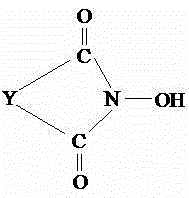The preparation method of diethylene acetate
A technology of ethylene diacetate and acetic acid is applied in the field of preparation of synthesizing ethylene diacetate from methyl acetate, and can solve the problem of low yield of ethylene diacetate, low selectivity, low conversion rate of methyl acetate, etc. problem, to achieve the effect of improving conversion rate and improving activity and stability
- Summary
- Abstract
- Description
- Claims
- Application Information
AI Technical Summary
Problems solved by technology
Method used
Image
Examples
Embodiment 1
[0018] Synthesis of ethylene diacetate: 2.5mol acetic acid, 0.02molPd(OAc) 2 , 0.1molCH 3 I. 0.063molN,N',N"-trihydroxyisocyanuric acid (formula II, THICA) and 0.62mol methyl acetate are added to the titanium reaction kettle, the air in the kettle is discharged with argon and the pressure is 2.0MPa. Then pass in carbon monoxide and hydrogen until the pressure is 7.5MPa, increase the stirring speed to 1200rpm, while stirring and heating to raise the temperature to the reaction temperature, control the reaction temperature to 178℃, the molar ratio of carbon monoxide to hydrogen is 33:17, continue the reaction for 7 hours, stop the reaction .
[0019] Product analysis: the reaction mixture obtained from the above reaction was cooled, decompressed, and separated, and the liquid phase was analyzed by gas chromatography-mass spectrometry (GC-MASS).
[0020] And calculate the yield and selectivity of synthetic ethylene diacetate according to the following formula:
[0021]
[0022]
[0023...
Embodiment 2
[0030] Synthesis of ethylene diacetate: 2.5mol acetic acid, 0.02molPd(OAc) 2 , 0.1molCH 3 I. 0.063molN,N'-dihydroxypyromellitic acid imide (formula V, NDHPI) and 0.62mol methyl acetate are added to the titanium reaction kettle, and the air in the kettle is first discharged with argon and then pressurized to 2.0MPa. Then pass in carbon monoxide and hydrogen until the pressure is 7.5MPa, increase the stirring speed to 1200rpm, while stirring and heating to raise the temperature to the reaction temperature, control the reaction temperature to 178℃, the molar ratio of carbon monoxide to hydrogen is 33:17, continue the reaction for 7 hours, stop the reaction .
[0031] Product analysis: the reaction mixture obtained from the above reaction was cooled, decompressed, and separated, and the liquid phase was analyzed by gas chromatography-mass spectrometry (GC-MASS).
[0032] The calculated conversion rate of methyl acetate is 70.82%, the yield of diethylene acetate is 60.09%, and the selec...
Embodiment 3
[0034] Synthesis of ethylene diacetate: 2.5mol acetic acid, 0.02molPd(OAc) 2 , 0.1molCH 3 I. 0.063molN-hydroxyphthalimide (formula III, NHPI) and 0.62mol methyl acetate are added to the titanium reaction kettle, the air in the kettle is first discharged with argon and then the pressure is increased to 2.0MPa, and then passed The pressure of carbon monoxide and hydrogen is 7.5 MPa, the stirring speed is increased to 1200 rpm, and the temperature is raised to the reaction temperature while stirring and heating. The reaction temperature is controlled to be 178° C. The molar ratio of carbon monoxide and hydrogen is 33:17. After the reaction continues for 7 hours, the reaction is stopped.
[0035] Product analysis: The reaction mixture obtained from the above reaction is cooled, decompressed, and separated, and the liquid phase is analyzed by gas chromatography-mass spectrometry (GC-MASS).
[0036] The calculated conversion rate of methyl acetate is 70.54%, the yield of diethylene acetat...
PUM
 Login to View More
Login to View More Abstract
Description
Claims
Application Information
 Login to View More
Login to View More - R&D
- Intellectual Property
- Life Sciences
- Materials
- Tech Scout
- Unparalleled Data Quality
- Higher Quality Content
- 60% Fewer Hallucinations
Browse by: Latest US Patents, China's latest patents, Technical Efficacy Thesaurus, Application Domain, Technology Topic, Popular Technical Reports.
© 2025 PatSnap. All rights reserved.Legal|Privacy policy|Modern Slavery Act Transparency Statement|Sitemap|About US| Contact US: help@patsnap.com



